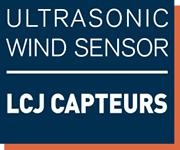
Wind sensor accuracy
The accuracy of ultrasonic wind sensors is characterised by the stability of results over time, without any maintenance.
The accuracy of LCJ Capteurs sonic wind vane-anemometers has been tested in wind tunnels by numerous laboratories: École Centrale de Nantes, LCPC, CERN, Météo-France, KNMI, etc…
Each sensor is tested before leaving the factory

Test bench in wind tunnel
The capacity of our wind tunnel enables measurements from 2m/s to 40m/s (4 knots to 80 knots).
A mechanism controlled by a PC generates the rotation of the sensor. It enables simultaneous verification of the wind vane and anemometer functions.
Each sensor is tested in our own wind tunnel at 19 knots.
Random samples are tested at 4, 10, 15, 30, 40 and 80 knots.
We are able to establish test reports conducted with different specific wind speeds.
Examples of calibration tests:
Temperature test bench
Each sensor is tested in our own environmental test chamber from -10°C to +50°C for the CV3F and from -15°C to +55°C for the CV7.
Measurements are taken at extreme temperatures and at +20°C.
Temperature progression variation is 2°C per minute, then stabilisation for one hour.
Random samples are submitted to tests on 5 measurement points, as well as for thermal shocks.
EMC compliance
LCJ Capteurs’ products comply with CE standards.
The wind sensor range EMC compliance is approved by an independent laboratory.

Field testing of the sensors
The CV3F was the first ultrasonic sensor released by LCJ CAPTEURS in 2000. Its reliability was proven with a one year in-field test mounted on the rear stand of French trawlers from Boulogne and Lorient, fishing in the North Sea and Irish Seas. Since 2001, the CV3F sensor has shown its resistance to environmental conditions: sea spray, vibrations and waves.
In rough weather, the absence of mobile parts highly contributes to the wind sensor’s longevity.
Over the years, many regatta sailors and offshore racers have put their trust in the wind measurement technology developed by LCJ Capteurs. In 2007, the CV7 aerial sensor was launched on the market, in order to meet their requirements for accuracy and reactivity in low wind conditions, even while heeling.
Multi-purpose sensors
On the market since 2007, the sensors of the CV7 and SONIC-ANEMO ranges have also been tested and approved in various terrestrial domains:
– industry
– public safety
– amusement parks
– fire departments
– wind energy
– vehicles
– drones and parachuted beacons
LCJ Capteurs was the first manufacturer to provide self-powered sonic wind vane-anemometers to meet the new requirements of connected devices (IOT)
